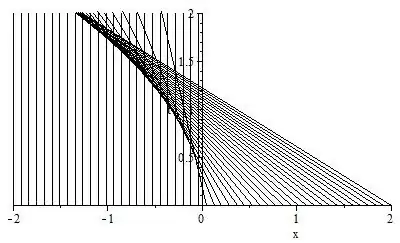$\DeclareMathOperator{\supp}{supp}\def\d{\mathrm{d}}\def\peq{\mathrm{\phantom{=}}{}}$Note that $u_t + u u_x = u_t + \left( \dfrac{u^2}{2} \right)_x = 0$ holds for $x > -\dfrac{t^2}{4}$, and $u = 0$ for $x < -\dfrac{t^2}{4}$. Denote$$
g(x) = u(x, 0) = \begin{cases}
-\dfrac{2\sqrt{x}}{\sqrt{3}}; & x > 0\\
0; & x < 0
\end{cases}.
$$
For any test function $v$, suppose $\supp(v) \subseteq \left( -\dfrac{T^2}{4}, \dfrac{T^2}{4} \right) × [0, T)$, then\begin{align*}
&\peq \int_0^{+∞} \int_{-∞}^{+∞} uv_t \,\d x\d t = \int_0^T \int_{-\tfrac{T^2}{4}}^{\tfrac{T^2}{4}} uv_t \,\d x\d t = \int_{-\tfrac{T^2}{4}}^{\tfrac{T^2}{4}} \int_0^T uv_t \,\d t\d x\\
&= \int_{-\tfrac{T^2}{4}}^0 \int_{\sqrt{-4x}}^T uv_t \,\d t\d x + \int_0^{\tfrac{T^2}{4}} \int_0^T uv_t \,\d t\d x\\
&= \int_{-\tfrac{T^2}{4}}^0 \left( uv \Biggr|_{t = \sqrt{-4x}}^{t = T} uv_t - \int_{\sqrt{-4x}}^T u_tv \,\d t \right)\d x + \int_0^{\tfrac{T^2}{4}} \left( uv \Biggr|_{t = 0}^{t = T} - \int_0^T u_tv \,\d t \right)\d x\\
&= - \left( \int_{-\tfrac{T^2}{4}}^0 \int_{\sqrt{-4x}}^T u_tv \,\d t\d x + \int_0^{\tfrac{T^2}{4}} \int_0^T u_tv \,\d t\d x \right)\\
&\peq + \int_{-\tfrac{T^2}{4}}^0 uv \Biggr|_{t = \sqrt{-4x}}^{t = T} \,\d x + \int_0^{\tfrac{T^2}{4}} uv \Biggr|_{t = 0}^{t = T} \,\d x\\
&= -\int_{-\tfrac{T^2}{4}}^{\tfrac{T^2}{4}} \int_0^T u_tv \,\d t\d x - \int_{-\tfrac{T^2}{4}}^0 uv \Biggr|_{t = \sqrt{-4x}} \,\d x - \int_0^{\tfrac{T^2}{4}} uv \Biggr|_{t = 0} \,\d x\\
&= -\int_0^T \int_{-\tfrac{T^2}{4}}^{\tfrac{T^2}{4}} u_tv \,\d x\d t + \int_{-\tfrac{T^2}{4}}^0 2\sqrt{-x} · v(x, \sqrt{-4x}) \,\d x - \int_0^{\tfrac{T^2}{4}} g(x) v(x, 0) \,\d x\\
&= -\int_0^T \int_{-\tfrac{T^2}{4}}^{\tfrac{T^2}{4}} u_tv \,\d x\d t + \int_0^T \frac{t^2}{2} · v\left( -\frac{t^2}{4}, t \right) \,\d t - \int_0^{\tfrac{T^2}{4}} g(x) v(x, 0) \,\d x,
\end{align*}\begin{align*}
&\peq \int_0^{+∞} \int_{-∞}^{+∞} \frac{u^2}{2} · v_x \,\d x\d t = \int_0^T \int_{-\tfrac{T^2}{4}}^{\tfrac{T^2}{4}} \frac{u^2}{2} · v_x \,\d x\d t = \int_0^T \int_{-\tfrac{t^2}{4}}^{\tfrac{T^2}{4}} \frac{u^2}{2} · v_x \,\d x\d t\\
&= \int_0^T \left( \frac{u^2}{2} · v\Biggr|_{x = -\tfrac{t^2}{4}}^{x = \tfrac{T^2}{4}} - \int_{-\tfrac{t^2}{4}}^{\tfrac{T^2}{4}} \left( \frac{u^2}{2} \right)_x · v \,\d x \right) \d t\\
&= -\int_0^T \frac{t^2}{2} · v\left( -\frac{t^2}{4}, t \right) \,\d t - \int_0^T \int_{-\tfrac{T^2}{4}}^{\tfrac{T^2}{4}} uu_xv \,\d x\d t,
\end{align*}$$
\int_{-∞}^{+∞} g(x) v(x, 0) \,\d x = \int_0^{\tfrac{T^2}{4}} g(x) v(x, 0) \,\d x,
$$
thus\begin{align*}
&\peq \int_0^{+∞} \int_{-∞}^{+∞} \left( uv_t + \frac{u^2}{2} · v_x \right) \,\d x\d t + \int_{-∞}^{+∞} g(x) v(x, 0) \,\d x\\
&= -\int_0^T \int_{-\tfrac{T^2}{4}}^{\tfrac{T^2}{4}} u_tv \,\d x\d t - \int_0^T \int_{-\tfrac{T^2}{4}}^{\tfrac{T^2}{4}} uu_xv \,\d x\d t\\
&= -\int_0^T \int_{-\tfrac{T^2}{4}}^{\tfrac{T^2}{4}} (u_t + uu_x) v \,\d x\d t = 0.
\end{align*}
Therefore, $u(x, t)$ is a weak solution.
Finally, since $u(x, t)$ is decreasing with respect to $x$, then$$
u(x + z, t) - u(x, t) \leqslant 0 \leqslant \left( 1 + \frac{1}{t} \right) z. \quad \forall x \in \mathbb{R},\ z > 0,\ t > 0
$$
